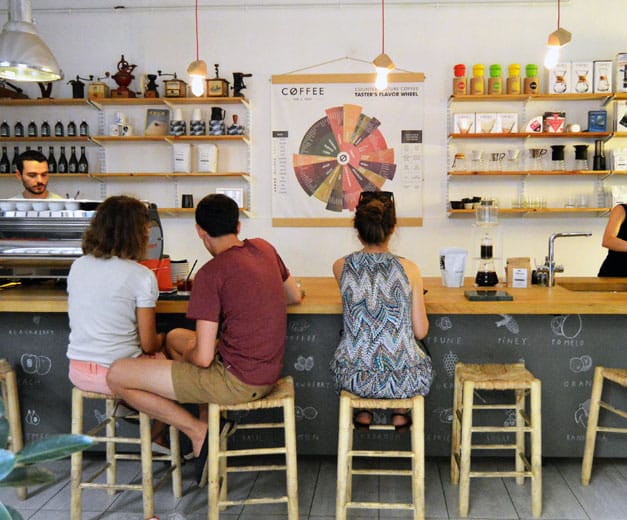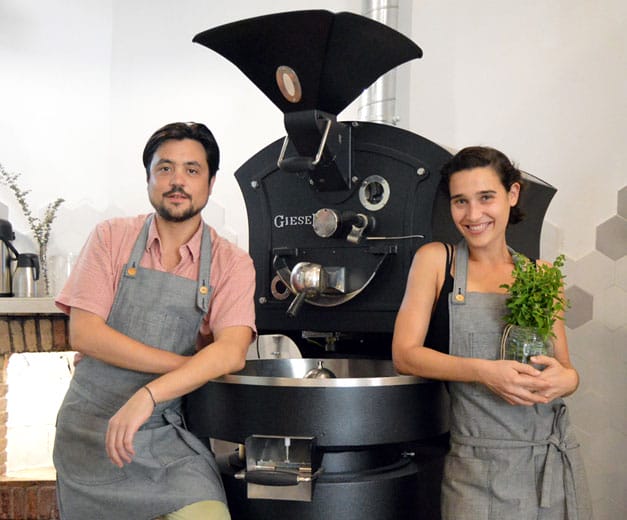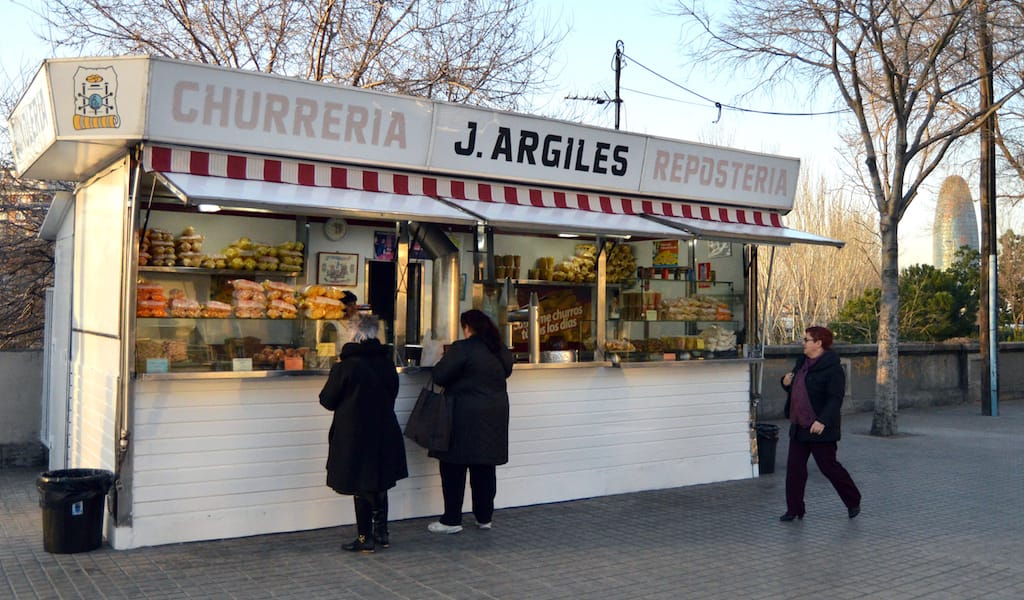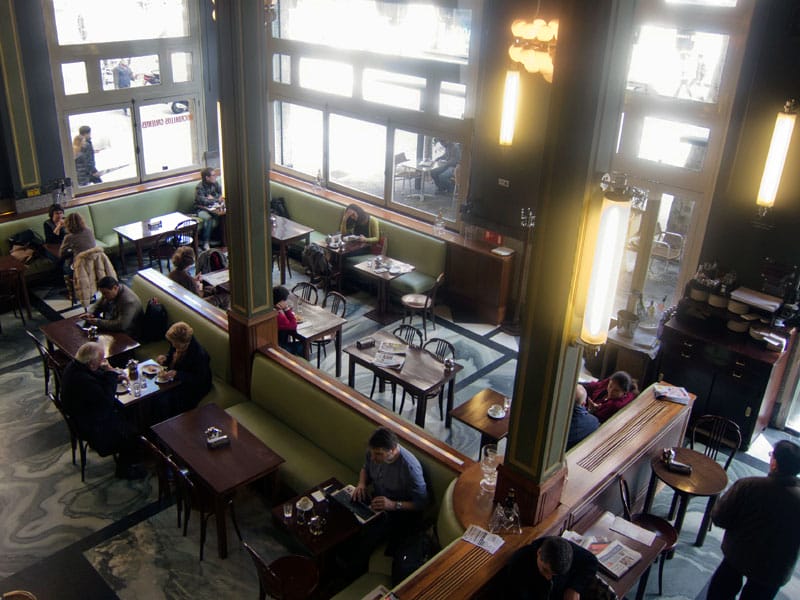In Spain, as in the U.S. and elsewhere – even as we hit coffee pod peak – a new multicultural generation of specialty coffee shops are discovering and sharing with their customers the best ways to experience all the special characteristics of truly great coffee.
Spain’s cities share the urban Mediterranean tradition of strong short coffee, very much influenced by Italian espresso and served in small cups or glasses, with tons of sugar and perhaps also liquors (orujo or aguardiente, anís, coñac). Much of the time, the quality of this coffee could really hurt your body and soul. It’s made from cheap, low-quality Robusta beans that undergo torrefacto (toasted at 200 degrees C with sugar) – once a technique to keep flavor and increase weight but now widely regarded as a way to hide terrible qualities or to ruin any coffee. At the same time, in the countryside and in small villages, café de puchero, coffee made in a pot and filtered with a cloth, much lighter and more diluted than espresso, was always the brewing method of choice before the rise of the stovetop moka pot.
But the new generation of coffee connoisseurs champions highly regarded Arabica beans from the best small-scale plantations, grinding those beans to order and using a wide range of brewing methods (aero-press, pourover, V60 filter, siphon, drip, etc.) as well as perfect temperatures and precise times and quantities to get delightfully nuanced, sophisticated and flavorful brews. Of course, they all offer great espressos made exactingly with their awesomely high-tech machines.
Hot or cold, in a cup, glass or even bottle, cappuccino or ristretto, long-filtered, cold drip or cold brew, still or with bubbles, with milk or not, suggestively aromatic and light or deep and dark: Barcelona is a coffee wonderland, and these are two of our favorite spots to get our fix.
Satan’s Coffee Corner
Coffee runs in Marcos Bartolomé’s veins: Four generations of his family have owned Cafés el Pato, the famed coffee roaster of Logroño in La Rioja. Ironically, Bartolomé is so sensitive to caffeine that he’s better off not drinking it – tasting it is okay – so opening this pioneering coffee shop in 2012 was like making a deal with the devil. Hence the name.
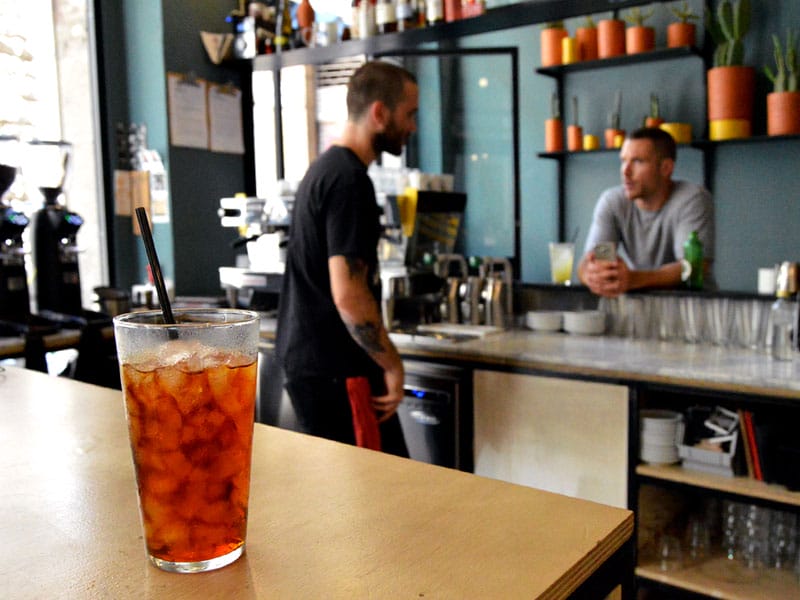
Bartolomé started with a small corner shop in El Raval but increased the size of his space and offerings when he moved the business to the Barrio Gótico and expanded it to include a restaurant serving healthy international cooking that complements coffee flavors. He’s opening an even bigger second location in L’Eixample, very close to Tetuan Square (Gran Vía 700). Coffee is available to stay or to take away, and all the beans were selected at their origin by Right Side Coffee Roasters, a Catalan concern in the nearby village of Castelldefels. In addition to roasting and serving coffee, the Satan’s-Right Side collaboration is very involved in education, offering free workshops and tastings for new baristas.
The menu is short but concise, and off-menu options – like cappuccinos – are available on request. Satan’s Coffee Corner uses four methods: pressure, infusion, precipitation and siphon.
Nømad Coffee
Opened just last year, Nømad started out as market stall in London. Founder Jordi Mestre, a Barcelonan, fell in love with coffee while working as a barista in London to pay for his studies (and subsequently won Spain’s barista competition twice). Mestre brought his shot-pulling skills back to his hometown in the form of a laboratory-shop. He joined forces with Belgian Kim Ossemblock (another much-decorated barista) to begin a project of roasting coffee and educating people about the different ways to enjoy specialty coffee. They recently opened a second location.
Mestre and Ossemblock buy coffee directly – always recently harvested – from small importers and producers. Then they roast it in small quantities to sell to bars and individual customers. Those roasts can be tasted at their two shops, but these are not coffee shops in the usual sense: There’s no sugar or milk; the focus is on the flavors of the coffees themselves. At the second location, in Poblenou, you can enjoy your coffee at a table surrounded by the intoxicating fragrance of the beans roasting in the room. We also love their bottles of cold brew for takeaway.
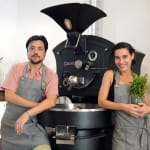 September 2, 2015 Best Buzz
September 2, 2015 Best Buzz
As we wrote in part one, specialty coffee has really taken off in Barcelona, after a […] Posted in Barcelona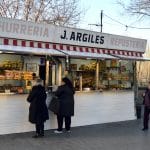 February 28, 2014 Barcelona’s Best Churros
February 28, 2014 Barcelona’s Best Churros
Churros, the long, skinny, crenellated, sweet fried crullers made from just flour, water […] Posted in Barcelona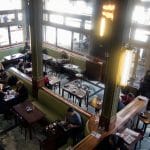 June 4, 2013 Ask CB: Local Cafés in Barcelona?
June 4, 2013 Ask CB: Local Cafés in Barcelona?
Dear Culinary Backstreets,
Where can I go in Barcelona when I'm tired of sightseeing […] Posted in Barcelona
Published on August 24, 2015
Related stories
September 2, 2015
BarcelonaAs we wrote in part one, specialty coffee has really taken off in Barcelona, after a long period of limited options and mediocre to bad beans and roasts. Here are a few more of our favorites among the new generation of coffee shops: True Artisan Café Elisabet Sereno, a Barcelonan nutritionist, coffee specialist, a founder…
February 28, 2014
BarcelonaChurros, the long, skinny, crenellated, sweet fried crullers made from just flour, water and salt, have been enjoyed for centuries in Spain, with hot chocolate and without. However, in Barcelona, xurros, as they are called in Catalan, are becoming an endangered species. In recent years, more than half of the xurrerias in the city have…
June 4, 2013
Barcelona | By Johanna Bailey
BarcelonaDear Culinary Backstreets, Where can I go in Barcelona when I'm tired of sightseeing and I just want to sit down and relax with a cup of coffee? Visiting museums and landmarks can be a lot of fun when you're a tourist but sometimes you can learn more about the life of a city by…







































